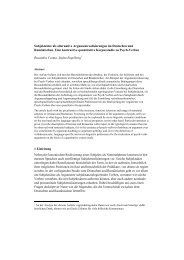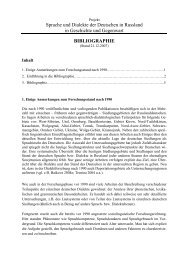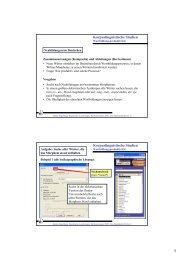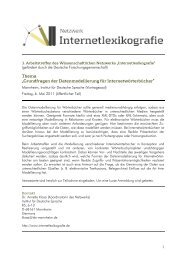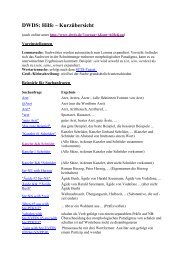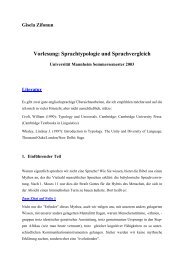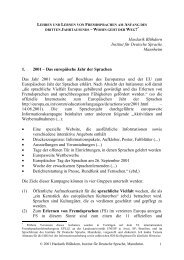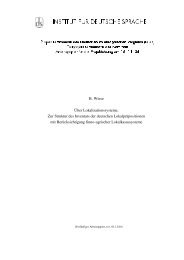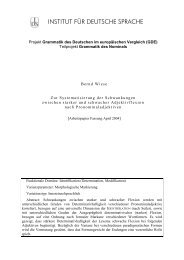Subordination and coordination in syntax, semantics and discourse ...
Subordination and coordination in syntax, semantics and discourse ...
Subordination and coordination in syntax, semantics and discourse ...
Create successful ePaper yourself
Turn your PDF publications into a flip-book with our unique Google optimized e-Paper software.
<strong>Subord<strong>in</strong>ation</strong> <strong>and</strong> <strong>coord<strong>in</strong>ation</strong>1998; Osborne 2003: 114ff). In example (1), all conjuncts (or coord<strong>in</strong><strong>and</strong>s; seeHaspelmath 2004) are V(erb)2-sentences.Op<strong>in</strong>ions differ about what may be the most adequate representation of thesyntactic structure of <strong>coord<strong>in</strong>ation</strong> (see e.g. Dik 1972; Wiese 1980; Wesche1995; Johannessen 1998; Camacho 2003; Osborne 2003, 2006; Eisenberg 2004:205ff, 377ff). Most but not all approaches assume structures <strong>in</strong> which bothcoord<strong>in</strong><strong>and</strong>s have equal status <strong>in</strong> relation to the coord<strong>in</strong>ator or some othercategory. One of the exceptions is Johannessen (1998: 108ff), who proposes astructure <strong>in</strong> which one coord<strong>in</strong><strong>and</strong> is the complement of the coord<strong>in</strong>ator, theother be<strong>in</strong>g its specifier. Her ma<strong>in</strong> <strong>in</strong>terest, however, is <strong>in</strong> so-called unbalanced,i.e. non-prototypical, <strong>coord<strong>in</strong>ation</strong>.In prototypical <strong>coord<strong>in</strong>ation</strong>, the morphosyntactic format of the coord<strong>in</strong><strong>and</strong>s isdef<strong>in</strong>ed <strong>in</strong>dependently of the coord<strong>in</strong>ator. Coord<strong>in</strong>ators neither selectcoord<strong>in</strong><strong>and</strong>s of a specific category nor do they require or attribute specificmorphosyntactic features. German has some connectives that behave similarly tocoord<strong>in</strong>ators, but nevertheless select relata of a certa<strong>in</strong> morphosyntactic format:denn [for], e.g., can only connect V2-clauses (see Duden 2005: 628), whereassowie [as well as] can only connect V-f<strong>in</strong>al-clauses <strong>and</strong> constituents lesscomplex than a clause (words or phrases) (see Bre<strong>in</strong>dl 2007b). Connectives witha similar non-prototypical behaviour can be found <strong>in</strong> several languages: for <strong>and</strong>as well as <strong>in</strong> English, car <strong>and</strong> a<strong>in</strong>si que <strong>in</strong> French, JG\ <strong>and</strong> oraz <strong>in</strong> Polish, etc.Prototypical coord<strong>in</strong>ators <strong>and</strong> similar elements are strongly constra<strong>in</strong>ed as totheir l<strong>in</strong>ear position <strong>in</strong> relation to the coord<strong>in</strong><strong>and</strong>s. In German, they must bepositioned <strong>in</strong> the middle between the coord<strong>in</strong><strong>and</strong>s, with a slightly strongeraff<strong>in</strong>ity to the right one:(2a) Ihr kauft e<strong>in</strong> und wir warten hier an der Ecke.[you can go shopp<strong>in</strong>g <strong>and</strong> we’ll wait here at the corner](2b) *Und wir warten hier an der Ecke ihr kauft e<strong>in</strong>.[<strong>and</strong> we’ll wait here at the corner you can go shopp<strong>in</strong>g]If two coord<strong>in</strong>ate clauses are separated by a comma or period, then it is<strong>in</strong>variably put to the left of the coord<strong>in</strong>ator <strong>and</strong> not to its right:(2c) Ihr kauft e<strong>in</strong>. Und wir warten hier an der Ecke.[you can go shopp<strong>in</strong>g. <strong>and</strong> we’ll wait here at the corner](2d) *Ihr kauft e<strong>in</strong> und. Wir warten hier an der Ecke.[you can go shopp<strong>in</strong>g <strong>and</strong>. we’ll wait here at the corner]© 2007 Hardarik Blühdorn, Institut für Deutsche Sprache, Mannheim. 5
Hardarik BlühdornIn other languages, coord<strong>in</strong>ators may take other l<strong>in</strong>ear positions (e.g. Lat<strong>in</strong> -que,which is a suffix added to the second coord<strong>in</strong><strong>and</strong>). In general their positions aremuch more constra<strong>in</strong>ed than the positions of any other class of connectives (seeHaspelmath 2004: 6ff; also Osborne 2006). We can therefore say thatcoord<strong>in</strong>ators connect their coord<strong>in</strong><strong>and</strong>s basically by l<strong>in</strong>ear sequence.2.2 Subord<strong>in</strong>ative connectionsOne of several means to establish subord<strong>in</strong>ative connections between clauses aresubord<strong>in</strong>at<strong>in</strong>g conjunctions (adverbial subord<strong>in</strong>ators; see Kortmann 1996), likewährend [while]:(3) Die P<strong>in</strong>gu<strong>in</strong>e waren braun-gelb, während die Giraffen schwarz-weißwaren.[the pengu<strong>in</strong>s were yellow-brown, while the giraffes were black <strong>and</strong>white]Subord<strong>in</strong>at<strong>in</strong>g conjunctions <strong>in</strong>fluence the morphosyntactic format of one of theirrelata (the subord<strong>in</strong>ate clause). The authors of the H<strong>and</strong>buch der deutschenKonnektoren (Pasch et al. 2003: 8ff, 106ff) call this relatum the <strong>in</strong>ternalargument. The relation between the subord<strong>in</strong>at<strong>in</strong>g conjunction <strong>and</strong> its <strong>in</strong>ternalargument is described as a type of government: <strong>in</strong> German, subord<strong>in</strong>at<strong>in</strong>gconjunctions select V-f<strong>in</strong>al order of their <strong>in</strong>ternal argument; <strong>in</strong> many languagesthey require certa<strong>in</strong> tense <strong>and</strong>/or mood forms of the subord<strong>in</strong>ate verb. On theother h<strong>and</strong>, subord<strong>in</strong>at<strong>in</strong>g conjunctions do not have any <strong>in</strong>fluence on themorphosyntactic format of their external argument (the ma<strong>in</strong> clause) (see ibid.:361, 416f). Subord<strong>in</strong>ative connections are therefore structurally asymmetric.While the relata of coord<strong>in</strong>ators are typically of the same morphosyntacticcategory, the relata of subord<strong>in</strong>at<strong>in</strong>g conjunctions typically belong to differentmorphosyntactic categories. They can be dist<strong>in</strong>guished <strong>in</strong> functional terms asma<strong>in</strong> <strong>and</strong> subord<strong>in</strong>ate clauses, or formally as clauses with certa<strong>in</strong>morphosyntactic properties, e.g. V2 <strong>and</strong> V-f<strong>in</strong>al. But categorical differencesbetween the relata are by no means obligatory <strong>in</strong> subord<strong>in</strong>ative connections.Both relata can be of the same category, if, for <strong>in</strong>dependent reasons, the externalargument is a subord<strong>in</strong>ate clause as well:(4) Maria erzählte, dass [die P<strong>in</strong>gu<strong>in</strong>e braun-gelb waren, während (dieGiraffen schwarz-weiß waren) V-f<strong>in</strong>al ] V-f<strong>in</strong>al .[Mary told us that (the pengu<strong>in</strong>s were yellow-brown, while (the giraffeswere black <strong>and</strong> white))]6© 2007 Hardarik Blühdorn, Institut für Deutsche Sprache, Mannheim.
<strong>Subord<strong>in</strong>ation</strong> <strong>and</strong> <strong>coord<strong>in</strong>ation</strong>In such cases the morphosyntactic form of the external argument is neverdeterm<strong>in</strong>ed by the connective.Prototypical coord<strong>in</strong>ators can connect expressions of any morphosyntacticcategory. Subord<strong>in</strong>at<strong>in</strong>g conjunctions, <strong>in</strong> contrast, can only connect clauses. Thislimitation is largely compensated for by adpositions, which are formally <strong>and</strong>functionally very similar to subord<strong>in</strong>at<strong>in</strong>g conjunctions, but which take nounphrases <strong>in</strong>stead of clauses as at least one of their relata (see Kortmann 1996: 25,58ff, 66ff):(5) die Vorkommnisse während der Abschlussfeier[the occurrences dur<strong>in</strong>g the leav<strong>in</strong>g party]It is a well-known fact that <strong>in</strong> German, as <strong>in</strong> many other languages, clauses canbe transformed <strong>in</strong>to noun phrases (see Hopper & Thompson 1984: 737f, 744ff;O’Dowd 1992; Eisenberg 2004: 252ff). The expressions result<strong>in</strong>g fromnom<strong>in</strong>alization must then be connected by adpositions <strong>in</strong>stead of subord<strong>in</strong>at<strong>in</strong>gconjunctions. Adpositions require their <strong>in</strong>ternal argument to adopt a specificcase form, but they have no <strong>in</strong>fluence on the morphosyntactic form of theirexternal argument.Subord<strong>in</strong>at<strong>in</strong>g conjunctions <strong>and</strong> adpositions have a fixed serial position <strong>in</strong>relation to their <strong>in</strong>ternal, but not to their external argument. In German, theytypically take a position at the left marg<strong>in</strong> of their <strong>in</strong>ternal argument. Theystructurally embed their <strong>in</strong>ternal argument <strong>in</strong>to the external argument. In thel<strong>in</strong>ear structure of the external argument they can be moved rather freelytogether with their <strong>in</strong>ternal argument. In particular, they can be postposed (as <strong>in</strong>(6/7a)), preposed (as <strong>in</strong> (6/7b)) <strong>and</strong> – at least for subord<strong>in</strong>at<strong>in</strong>g conjunctions –even be <strong>in</strong>terposed to the external argument (as <strong>in</strong> (6c)).Subord<strong>in</strong>at<strong>in</strong>g conjunction:(6a) Wir warten hier an der Ecke, solange ihr e<strong>in</strong>kauft.[we’ll wait here at the corner, while you go shopp<strong>in</strong>g](6b) Solange ihr e<strong>in</strong>kauft, warten wir hier an der Ecke.[while you go shopp<strong>in</strong>g, we’ll wait here at the corner](6c) Wir warten, solange ihr e<strong>in</strong>kauft, hier an der Ecke.[we’ll wait, while you go shopp<strong>in</strong>g, here at the corner]© 2007 Hardarik Blühdorn, Institut für Deutsche Sprache, Mannheim. 7
Hardarik BlühdornAdposition:(7a) die Aufräumarbeiten nach der Abschlussfeier (waren ermüdend)[the clean<strong>in</strong>g work after the leav<strong>in</strong>g party (was exhaust<strong>in</strong>g)](7b) nach der Abschlussfeier die Aufräumarbeiten (waren ermüdend)[after the leav<strong>in</strong>g party the clean<strong>in</strong>g work (was exhaust<strong>in</strong>g)]Thus, subord<strong>in</strong>at<strong>in</strong>g conjunctions <strong>and</strong> adpositions (subord<strong>in</strong>ators) do not l<strong>in</strong>ktheir relata by l<strong>in</strong>ear sequence, but by government <strong>and</strong> embedd<strong>in</strong>g.2.3 Adverbial connectionsCoord<strong>in</strong>ative <strong>and</strong> subord<strong>in</strong>ative connections of the k<strong>in</strong>ds discussed so far areestablished by syntactic means such as l<strong>in</strong>ear order<strong>in</strong>g, government <strong>and</strong>embedd<strong>in</strong>g. They clearly fall with<strong>in</strong> the scope of <strong>syntax</strong>.Semantically equivalent connections can also be encoded by means of adverbialconnectives. In the follow<strong>in</strong>g pairs of examples, the (a)-variants encode theconnection by means of a subord<strong>in</strong>ator or coord<strong>in</strong>ator, whereas the (b)-variantsencode a semantically equivalent connection by means of an adverbialconnective:(8a) Die P<strong>in</strong>gu<strong>in</strong>e waren braun-gelb, während die Giraffen schwarz-weißwaren. (subord<strong>in</strong>at<strong>in</strong>g conjunction)[the pengu<strong>in</strong>s were yellow-brown, while the giraffes were black <strong>and</strong>white](8b) Die P<strong>in</strong>gu<strong>in</strong>e waren braun-gelb. Die Giraffen dagegen waren schwarzweiß.(adverbial connective)[the pengu<strong>in</strong>s were yellow-brown. the giraffes, <strong>in</strong> contrast, were black<strong>and</strong> white](9a) Die Aufräumarbeiten nach der Abschlussfeier waren sehr anstrengend.(adposition)[the clean<strong>in</strong>g work after the leav<strong>in</strong>g party was very exhaust<strong>in</strong>g](9b) Die Abschlussfeier war e<strong>in</strong> großer Erfolg. Die Aufräumarbeiten danachwaren sehr anstrengend. (adverbial connective)[the leav<strong>in</strong>g party was a great success. the clean<strong>in</strong>g work afterwards wasvery exhaust<strong>in</strong>g]8© 2007 Hardarik Blühdorn, Institut für Deutsche Sprache, Mannheim.
<strong>Subord<strong>in</strong>ation</strong> <strong>and</strong> <strong>coord<strong>in</strong>ation</strong>(10a) Es gab da überhaupt ke<strong>in</strong>e Action-Abteilung, und ich war von Tag zu Tagmieser gelaunt. (coord<strong>in</strong>at<strong>in</strong>g conjunction)[they didn’t even have an action department, <strong>and</strong> my mood got worse bythe day](10b) Es gab da überhaupt ke<strong>in</strong>e Action-Abteilung. Zudem war ich von Tag zuTag mieser gelaunt. (adverbial connective)[they didn’t even have an action department. <strong>in</strong> addition, my mood gotworse by the day]Adverbial connectives are syntactic constituents of one of their semantic relata.They are attached to that relatum as adverbial adjuncts. They may <strong>in</strong>fluence thetense <strong>and</strong>/or mood of the verb of that relatum, but they do not <strong>in</strong>fluence themorphosyntactic format of their other relatum. To their other relatum, they donot bear any syntactic relation (see Pasch et al. 2003: 485).In relation to both connected expressions, adverbial connectives do not have afixed l<strong>in</strong>ear position. Like most adverbials, they can be moved relatively freelywith<strong>in</strong> the relatum of which they are a constituent, <strong>and</strong> though they typicallyoccur <strong>in</strong> the right (subsequent) relatum, they can also occur <strong>in</strong> the left(antecedent) relatum:(11) Wir warten hier so lange. Ich me<strong>in</strong>e, bis ihr mit dem E<strong>in</strong>kaufen fertigseid.[we’ll wait here for the time be<strong>in</strong>g. I mean until you have f<strong>in</strong>ishedshopp<strong>in</strong>g]Adverbial connectives l<strong>in</strong>k their relata neither by government <strong>and</strong> embedd<strong>in</strong>gnor by l<strong>in</strong>ear sequence. Instead, they connect them semantically or, moreprecisely, by reference. The semantic representation of an adverbial connectiveconta<strong>in</strong>s a slot for a referent that cannot be identified on grounds of the<strong>in</strong>formation provided by the sentence <strong>in</strong> which the adverbial is a constituent. Inorder to identify that referent, the <strong>in</strong>terpreter must look for the necessary<strong>in</strong>formation <strong>in</strong> the preced<strong>in</strong>g or follow<strong>in</strong>g context. Depend<strong>in</strong>g on where therequired <strong>in</strong>formation is placed, we can dist<strong>in</strong>guish between anaphoric (backwardoriented) <strong>and</strong> cataphoric (forward oriented) adverbial connections. Thus, theadverbial connectives dagegen [<strong>in</strong> contrast], danach [afterwards], <strong>and</strong> zudem [<strong>in</strong>addition], <strong>in</strong> (8b), (9b) <strong>and</strong> (10b) respectively, connect their relata anaphorically,whereas so lange [for the time be<strong>in</strong>g] <strong>in</strong> (11) connects its relata cataphorically.In many adverbial connectives of German, the referential element ismorphologically visible. Such connectives are results of word formationprocesses <strong>in</strong> which an adpositional <strong>and</strong> a pronom<strong>in</strong>al component have been© 2007 Hardarik Blühdorn, Institut für Deutsche Sprache, Mannheim. 9
Hardarik Blühdornfor those connections, whether they count as hierarchical or non-hierarchical canonly be decided on other than syntactic grounds.An additional observation may be made here about two groups of subord<strong>in</strong>atorswith pronom<strong>in</strong>al components. Some German subord<strong>in</strong>at<strong>in</strong>g conjunctions conta<strong>in</strong>such components, e.g. nachdem [after], <strong>in</strong>dem [as] or seitdem [s<strong>in</strong>ce].Subord<strong>in</strong>ators of this k<strong>in</strong>d derive historically from adverbs. Their pronom<strong>in</strong>alcomponents are residues with a very weak (if any) referential function left <strong>in</strong>present day use (on nachdem see Blühdorn 2004). A second group are relativeadverbs like weshalb [wherefore], wobei [whereby], worauf [whereupon] etc.,which conta<strong>in</strong> the pronom<strong>in</strong>al components wes- <strong>and</strong> wo-. Adverbs of this k<strong>in</strong>dcan be used to <strong>in</strong>troduce adverbial relative clauses. They establish a type ofconnection that comb<strong>in</strong>es referential l<strong>in</strong>k<strong>in</strong>g with l<strong>in</strong>k<strong>in</strong>g by government, thoughnot by embedd<strong>in</strong>g (see Pasch et al. 2003: 241ff, 422ff). The existence of thistype of l<strong>in</strong>k<strong>in</strong>g does not weaken my argument. I do not claim, <strong>in</strong> fact, thatreference has no role to play on sentence level, but that its role is not crucial forsyntactic connections. On the other h<strong>and</strong>, I do claim that syntactic l<strong>in</strong>k<strong>in</strong>gmechanisms such as government, embedd<strong>in</strong>g <strong>and</strong> syntactic serialization do notwork beyond the boundaries of the sentence, i.e. are neutralized on the level of<strong>discourse</strong>.3. Semantic connectionsStrictly speak<strong>in</strong>g, the term connective does not refer to a syntactic, but to asemantic category. Connectives are elements of several syntactic classes thatshare the function of encod<strong>in</strong>g semantically characterized relations betweenconceptual entities such as events <strong>and</strong> propositions (see Pasch et al. 2003: 1ff,38f; Blühdorn 2003; Lohnste<strong>in</strong> 2004). In <strong>semantics</strong>, as well as <strong>in</strong> <strong>syntax</strong>, we c<strong>and</strong>ist<strong>in</strong>guish between hierarchical <strong>and</strong> non-hierarchical connections.Accord<strong>in</strong>g to Lang (1984: 69ff), the semantic relata of coord<strong>in</strong>ative connectionsmust be tied up by a common <strong>in</strong>tegrator. This term refers to a superord<strong>in</strong>ateconceptual category, under which both relata can be subsumed, <strong>and</strong> under whichthey are <strong>in</strong> contrast with each other. In example (12), we can construe someth<strong>in</strong>glike “colours of zoo animals” as the common <strong>in</strong>tegrator:(12) Die P<strong>in</strong>gu<strong>in</strong>e waren braun-gelb und die Giraffen waren schwarz-weiß.[the pengu<strong>in</strong>s were yellow-brown, <strong>and</strong> the giraffes were black <strong>and</strong> white]For the verses by Udo L<strong>in</strong>denberg, a possible common <strong>in</strong>tegrator seems to be“motives that suggest abseil<strong>in</strong>g to the eternal underground”:12© 2007 Hardarik Blühdorn, Institut für Deutsche Sprache, Mannheim.
<strong>Subord<strong>in</strong>ation</strong> <strong>and</strong> <strong>coord<strong>in</strong>ation</strong>(13) Es gab da überhaupt ke<strong>in</strong>e Action-Abteilung, und ich war von Tag zu Tagmieser gelaunt.[they didn’t even have an action department, <strong>and</strong> my mood got worse bythe day]The examples show that the common <strong>in</strong>tegrator need by no means perta<strong>in</strong> togenerally accessible world knowledge. On the contrary, it may be construed adhoc, accord<strong>in</strong>g to the dem<strong>and</strong>s of each context <strong>in</strong> <strong>discourse</strong>.It might seem as if the requirement of a common <strong>in</strong>tegrator could be a goodcriterion to dist<strong>in</strong>guish between hierarchical <strong>and</strong> non-hierarchical connections <strong>in</strong><strong>semantics</strong>. But on a closer look we f<strong>in</strong>d that this requirement is not restricted tosemantically symmetrical nor to syntactically coord<strong>in</strong>ative connections. Rather,it is a characteristic of a much more extensive class of connections, which maybe symmetrical or asymmetric <strong>and</strong> which may be encoded by <strong>coord<strong>in</strong>ation</strong>,subord<strong>in</strong>ation or any other syntactic mechanism. In particular, all k<strong>in</strong>ds ofadverbial connections belong to this class, i.e., require a common <strong>in</strong>tegrator.Accord<strong>in</strong>g to a well-known model proposed by Lyons (1977: 442ff; 791ff), allconceptual entities can be divided <strong>in</strong>to four general categories: spatial (firstorder) entities, temporal (second order) entities, logical/epistemic (third order)entities <strong>and</strong> deontic (fourth order) entities (see also Kortmann 1996: 28ff). Firstorder entities are spatial objects, second order entities are states of affairs(<strong>in</strong>clud<strong>in</strong>g states <strong>and</strong> events), third order entities are propositions, <strong>and</strong> fourthorder entities are <strong>in</strong>tentional entities, which, for lack of a better term, I will callacts (see Blühdorn 2003: 16ff). The four general categories def<strong>in</strong>e fourconceptual doma<strong>in</strong>s: space, time, logic/episteme (the doma<strong>in</strong> of knowledge) <strong>and</strong>ethics/deontics (the doma<strong>in</strong> of <strong>in</strong>tentions <strong>and</strong> act<strong>in</strong>g).It is a general semantic requirement on adverbial connections (subord<strong>in</strong>ative ornot), as well as on coord<strong>in</strong>ative connections, that their relata must belong to thesame conceptual doma<strong>in</strong> <strong>and</strong>, consequently, be of the same general category.Thus, <strong>in</strong> order to connect two relata spatially, both must be spatial objects; <strong>in</strong>order to connect them temporally, both must be states of affairs; <strong>in</strong> order toconnect them logically, both must be propositions; <strong>and</strong> <strong>in</strong> order to connect themdeontically, both must be acts (for more details see Blühdorn 2007a, 2007b).It can be concluded that the requirement of a common <strong>in</strong>tegrator is not anappropriate criterion for dist<strong>in</strong>guish<strong>in</strong>g between hierarchical <strong>and</strong> nonhierarchicalconnections <strong>in</strong> <strong>semantics</strong>. A better criterion seems to be relationalsymmetry. Non-hierarchical semantic connections are symmetrical. Their relatahave equal semantic functions <strong>and</strong> equal semantic weight (see Bre<strong>in</strong>dl 2007b:© 2007 Hardarik Blühdorn, Institut für Deutsche Sprache, Mannheim. 13
Hardarik Blühdorn144). One of the syntactic consequences of semantic symmetry is the possibilityof <strong>in</strong>vert<strong>in</strong>g the sequence of the relata without a significant change of mean<strong>in</strong>g.The relata <strong>in</strong> the follow<strong>in</strong>g example are symmetrically connected. They can be<strong>in</strong>verted without semantic consequences:(14a) Die P<strong>in</strong>gu<strong>in</strong>e waren braun-gelb und die Giraffen waren schwarz-weiß.[the pengu<strong>in</strong>s were yellow-brown, <strong>and</strong> the giraffes were black <strong>and</strong> white](14b) Die Giraffen waren schwarz-weiß und die P<strong>in</strong>gu<strong>in</strong>e waren braun-gelb.[the giraffes were black <strong>and</strong> white, <strong>and</strong> the pengu<strong>in</strong>s were yellow-brown]Hierarchical semantic connections, <strong>in</strong> contrast, are asymmetric. Chang<strong>in</strong>g thesyntactic sequence of their relata will significantly change the mean<strong>in</strong>g. Wherean <strong>in</strong>version of the relata gives rise to such a change of mean<strong>in</strong>g, it can beconcluded that the connection is not understood as symmetrical, even if it issyntactically encoded by a coord<strong>in</strong>ator:(15a) Maria g<strong>in</strong>g <strong>in</strong> die Bibliothek und sie bekam Hunger.[Mary went to the library, <strong>and</strong> she began to feel hungry](15b) Maria bekam Hunger und sie g<strong>in</strong>g <strong>in</strong> die Bibliothek.[Mary began to feel hungry, <strong>and</strong> she went to the library ]In the most plausible read<strong>in</strong>g of these examples, the connected events areordered <strong>in</strong> a temporal sequence, which is <strong>in</strong>verted from (15a) to (15b). It is notuncommon for syntactically coord<strong>in</strong>ative connections to be <strong>in</strong>terpreted <strong>in</strong>semantically asymmetric ways – an effect that can be expla<strong>in</strong>ed by very generalcognitive <strong>and</strong> pragmatic pr<strong>in</strong>ciples (see Grice 1981: 185f; Posner 1980: 182ff;Lang 1984: 80ff; Bre<strong>in</strong>dl 2007a). The examples show that syntactic <strong>coord<strong>in</strong>ation</strong><strong>and</strong> semantic symmetry must be carefully dist<strong>in</strong>guished. By no means can theybe identified with each other.The relata of asymmetric connections cannot be <strong>in</strong>verted without significantsemantic consequences. They have different relational (thematic) roles. One ofthem is be<strong>in</strong>g connected (like a ship that drops its anchor), the other is what it isbe<strong>in</strong>g connected to (like the sea ground <strong>in</strong> which the anchor is fixed). In RonaldLangacker’s (1987: 231ff) term<strong>in</strong>ology, the former is called trajector (T) <strong>and</strong> thelatter l<strong>and</strong>mark (L).Three types of asymmetric connections can be dist<strong>in</strong>guished (see Blühdorn2003: 19f; Blühdorn 2005: 315f):14© 2007 Hardarik Blühdorn, Institut für Deutsche Sprache, Mannheim.
<strong>Subord<strong>in</strong>ation</strong> <strong>and</strong> <strong>coord<strong>in</strong>ation</strong>• situat<strong>in</strong>g connections• conditional connections• causal connectionsSituat<strong>in</strong>g connections are stative. They assign to the trajector a place <strong>in</strong> aconceptual doma<strong>in</strong>, which is described by a relation to the l<strong>and</strong>mark:(16) Bevor du nach Hause gehst (L), lösch bitte das Licht (T).[before you go home (L), please switch off the light (T)]Switch<strong>in</strong>g off the light is the trajector that is situated on the time scale <strong>in</strong> relationto the event of go<strong>in</strong>g home (l<strong>and</strong>mark). Switch<strong>in</strong>g off the light <strong>and</strong> go<strong>in</strong>g homethemselves are evidently non-stative, but their sequential relation on the timescale, encoded by the conjunction before, is stative. Each of the events has itsfixed position <strong>in</strong> time, <strong>and</strong> the position of the trajector is def<strong>in</strong>ed on grounds ofthe position of the l<strong>and</strong>mark.Conditional connections are dynamic: the l<strong>and</strong>mark event not only situates thetrajector event, but it also <strong>in</strong>fluences the value to be taken by the trajector event.It is not yet clear if the trajector event will <strong>in</strong> fact become real (or come true).This depends on the value to be taken by the l<strong>and</strong>mark event:(17) Und sehn wir uns nicht <strong>in</strong> dieser Welt (L), dann sehn wir uns <strong>in</strong> Bielefeld(T).[<strong>and</strong> if we won’t meet <strong>in</strong> this world (L), then we’ll catch up <strong>in</strong> Bielefeld(T)]The example tells us that the meet<strong>in</strong>g <strong>in</strong> Bielefeld will take place on thecondition that the meet<strong>in</strong>g <strong>in</strong> this world does not.Causal connections are dynamic as well, but <strong>in</strong> a causal connection the value ofthe trajector event is already fixed. The trajector event is real, <strong>and</strong> the l<strong>and</strong>markevent has <strong>in</strong>fluenced the fix<strong>in</strong>g of its value:(18) Ich war von Tag zu Tag mieser gelaunt (T), weil es gab da überhauptke<strong>in</strong>e Action-Abteilung (L).[my mood got worse by the day (T), for they didn’t even have an actiondepartment (L)]The <strong>in</strong>existence of an action department is the cause which led to the change ofthe speaker’s mood. The result is presented as factual, i.e. as a state of affairswith a fixed reality value.© 2007 Hardarik Blühdorn, Institut für Deutsche Sprache, Mannheim. 15
Hardarik BlühdornThe dist<strong>in</strong>ction between semantically symmetrical <strong>and</strong> asymmetric connectionscan be made with<strong>in</strong> the boundaries of the sentence (on <strong>in</strong>tra-sentence level) <strong>and</strong>also between sentences <strong>in</strong> <strong>discourse</strong> (on <strong>in</strong>ter-sentence level). Both k<strong>in</strong>ds ofsemantic connection can be encoded by coord<strong>in</strong>ators as well as by subord<strong>in</strong>ators<strong>and</strong> also by adverbial connectives. Some further examples may illustrate thispo<strong>in</strong>t:(19a) Das ist ke<strong>in</strong> Selbstbedienungsladen, und sonntags ist hier zu.[this is no self-service store, <strong>and</strong> on Sundays we are closed](19b) Sonntags ist hier zu, und das ist ke<strong>in</strong> Selbstbedienungsladen.[on Sundays we are closed, <strong>and</strong> this is no self-service store](19c) Das ist ke<strong>in</strong> Selbstbedienungsladen. Außerdem ist hier sonntags zu.[this is no self-service store. also, on Sundays we are closed](19d) Sonntags ist hier zu. Außerdem ist das ke<strong>in</strong> Selbstbedienungsladen.[on Sundays we are closed. also, this is no self-service store]The connections <strong>in</strong> (19a-d) are symmetrical. The sequence of their relata can be<strong>in</strong>verted without a significant change of mean<strong>in</strong>g. In (19a/b), the connection isencoded by a coord<strong>in</strong>ator (<strong>in</strong>tra-sentence level); <strong>in</strong> (19c/d), a semanticallyequivalent connection is encoded by an adverbial connective (<strong>in</strong>ter-sentencelevel). My argument for consider<strong>in</strong>g <strong>coord<strong>in</strong>ation</strong> of two ma<strong>in</strong> clauses an <strong>in</strong>trasentenceconnection is the syntactic constra<strong>in</strong>t on the position of the coord<strong>in</strong>ator,discussed <strong>in</strong> section 2. In addition, we can consider punctuation <strong>and</strong> <strong>in</strong>tonation.Coord<strong>in</strong>ated ma<strong>in</strong> clauses may be separated by a comma <strong>in</strong>stead of a period <strong>and</strong>may even not be separated by any punctuation mark. In spoken utterances, theycan be <strong>in</strong>cluded <strong>in</strong>to the same <strong>in</strong>tonational phrase.(20a) Wenn du ke<strong>in</strong>e Lust hast (L), gehe ich alle<strong>in</strong> (T).[if you don’t feel like it (L), I’ll go on my own (T)](20b) Wenn ich alle<strong>in</strong> gehe (L), hast du ke<strong>in</strong>e Lust (T).[if I go on my own (L), you won’t feel like it (T)](20c) Du hast ke<strong>in</strong>e Lust? (L) Dann gehe ich alle<strong>in</strong>. (T)[you don’t feel like it? (L) then I’ll go on my own (T)](20d) Ich gehe alle<strong>in</strong>? (L) Dann hast du ke<strong>in</strong>e Lust. (T)[I’ll go on my own? (L) then you won’t feel like it (T)]The examples <strong>in</strong> (20a-d) illustrate asymmetric connections. Invert<strong>in</strong>g thesequence of their relata leads to a significant change of mean<strong>in</strong>g. Theconnections <strong>in</strong> (20a/b) are encoded by a subord<strong>in</strong>ator (<strong>in</strong>tra-sentence level). In(20c/d), semantically equivalent connections are encoded by an adverbialconnective (<strong>in</strong>ter-sentence level).16© 2007 Hardarik Blühdorn, Institut für Deutsche Sprache, Mannheim.
<strong>Subord<strong>in</strong>ation</strong> <strong>and</strong> <strong>coord<strong>in</strong>ation</strong>On <strong>in</strong>tra-sentence level, symmetrical <strong>and</strong> asymmetric connections can beencoded by coord<strong>in</strong>ators as well as subord<strong>in</strong>ators:(21a) Die P<strong>in</strong>gu<strong>in</strong>e waren braun-gelb und die Giraffen waren schwarz-weiß.[the pengu<strong>in</strong>s were yellow-brown, <strong>and</strong> the giraffes were black <strong>and</strong> white](21b) Die Giraffen waren schwarz-weiß und die P<strong>in</strong>gu<strong>in</strong>e waren braun-gelb.[the giraffes were black <strong>and</strong> white, <strong>and</strong> the pengu<strong>in</strong>s were yellow-brown](21c) Die P<strong>in</strong>gu<strong>in</strong>e waren braun-gelb, während die Giraffen schwarz-weißwaren.[the pengu<strong>in</strong>s were yellow-brown, while the giraffes were black <strong>and</strong>white](21d) Die Giraffen waren schwarz-weiß, während die P<strong>in</strong>gu<strong>in</strong>e braun-gelbwaren.[the giraffes were black <strong>and</strong> white, while the pengu<strong>in</strong>s were yellowbrown](22a) Ich war von Tag zu Tag mieser gelaunt (T), weil es gab da überhauptke<strong>in</strong>e Action-Abteilung (L).[my mood got worse by the day (T), for they didn’t even have an actiondepartment (L)](22b) Es gab da überhaupt ke<strong>in</strong>e Action-Abteilung (T), weil ich war von Tag zuTag mieser gelaunt (L).[they didn’t even have an action department (T), for my mood got worseby the day (L)](22c) Ich war von Tag zu Tag mieser gelaunt (T), weil es da überhaupt ke<strong>in</strong>eAction-Abteilung gab (L).[my mood got worse by the day (T), because they didn’t even have anaction department (L)](22d) Es gab da überhaupt ke<strong>in</strong>e Action-Abteilung (T), weil ich von Tag zu Tagmieser gelaunt war (L).[they didn’t even have an action department (T), because my mood gotworse by the day (L)]The examples <strong>in</strong> (21a-d) illustrate symmetrical connections. In (21a/b), theconnections are encoded by a coord<strong>in</strong>ator. In (21c/d), the same relata aresymmetrically connected by a subord<strong>in</strong>ator. The examples <strong>in</strong> (22a-d) illustrateasymmetric connections. Inversion of the relata leads to a change of mean<strong>in</strong>g.The connections <strong>in</strong> (22a/b) are encoded by a (non-prototypical) coord<strong>in</strong>ator.Both relata are syntactically realized as ma<strong>in</strong> clauses. In (22b), the same relataare asymmetrically connected by a subord<strong>in</strong>ator. One of the relata is realized asa ma<strong>in</strong> clause, the other as a subord<strong>in</strong>ate clause.© 2007 Hardarik Blühdorn, Institut für Deutsche Sprache, Mannheim. 17
Hardarik BlühdornThe data discussed <strong>in</strong> this section are from Modern German, but data from otherlanguages could just as well have been used. From the observations made, it canbe concluded that the dist<strong>in</strong>ctions between syntactic <strong>coord<strong>in</strong>ation</strong> <strong>and</strong>subord<strong>in</strong>ation <strong>and</strong> semantic symmetry <strong>and</strong> asymmetry are <strong>in</strong>dependent of eachother. Connections of syntactic units <strong>and</strong> the connections of the encodedconceptual entities can be either parallel or non-parallel <strong>in</strong> structure.4. Discourse connectionsS<strong>in</strong>ce the 1980s, several models <strong>and</strong> theories of <strong>discourse</strong> structure have beenproposed, which have tried to give an explicit account of coherence relations <strong>in</strong>written <strong>and</strong> spoken text. All of them dist<strong>in</strong>guish <strong>in</strong> some way or another betweenhierarchical <strong>and</strong> non-hierarchical <strong>discourse</strong> relations. But they differconsiderably <strong>in</strong> how they motivate this dist<strong>in</strong>ction.4.1 Syntax <strong>and</strong> <strong>semantics</strong> as models for underst<strong>and</strong><strong>in</strong>g <strong>discourse</strong>structureOne obvious hypothesis is that <strong>discourse</strong> structure might be parallel to syntactic<strong>and</strong>/or semantic structure (see Hopper & Thompson 1984: 736f; O’Dowd 1992;Matthiessen & Thompson 1988; Mann & Thompson 1988: 269; Taboada &Mann 2006: 427). The <strong>and</strong>-variant of this hypothesis has often been assumed forcoord<strong>in</strong>ative relations. Coord<strong>in</strong>ated syntactic units are typically of the sameformal <strong>and</strong> functional category, <strong>and</strong> their l<strong>in</strong>ear order can be <strong>in</strong>verted withoutsemantic consequences. Symmetrically connected conceptual units are of thesame semantic category <strong>and</strong> have a common semantic function. Nonhierarchicallyconnected <strong>discourse</strong> units should belong to the same rhetoricalcategory <strong>and</strong> have a common <strong>discourse</strong> function.Many examples discussed <strong>in</strong> the literature seem to support the view thatsemantic symmetry <strong>and</strong> syntactic <strong>coord<strong>in</strong>ation</strong> are natural l<strong>in</strong>guistic means toencode non-hierarchical <strong>discourse</strong> relations. Yet we have seen <strong>in</strong> section 3 abovethat coord<strong>in</strong>ative connections <strong>in</strong> <strong>syntax</strong> are typically underspecified for semantic<strong>in</strong>terpretation. Depend<strong>in</strong>g on the context of the utterance, they may (or evenmust) receive an asymmetric read<strong>in</strong>g:(23) Maria g<strong>in</strong>g zu McDonald’s, und sie bekam Hunger.[Mary went to McDonald’s, <strong>and</strong> she began to feel hungry](23a) → Außerdem bekam sie Hunger.[also she began to feel hungry]18© 2007 Hardarik Blühdorn, Institut für Deutsche Sprache, Mannheim.
<strong>Subord<strong>in</strong>ation</strong> <strong>and</strong> <strong>coord<strong>in</strong>ation</strong>(23b) →(23c) →Dann bekam sie Hunger.[then she began to feel hungry]Deshalb bekam sie Hunger.[therefore she began to feel hungry](23a) to (23c) are possible <strong>in</strong>terpretations of the second part of (23). (23a) is asymmetrical read<strong>in</strong>g. The two connected propositions have equal status: twopredicates which are true of Mary. (23b) <strong>and</strong> (23c) are asymmetric read<strong>in</strong>gs of(23). (23b) is a situat<strong>in</strong>g <strong>in</strong>terpretation: Mary’s go<strong>in</strong>g to McDonald’s is thel<strong>and</strong>mark, her beg<strong>in</strong>n<strong>in</strong>g to feel hungry is the trajector. (23c) is a causal<strong>in</strong>terpretation: go<strong>in</strong>g to McDonald’s is the causal l<strong>and</strong>mark, feel<strong>in</strong>g hungry thecausal trajector. Most theories of <strong>discourse</strong> structure have paid little attention tothe multiple <strong>in</strong>terpretability of coord<strong>in</strong>ative syntactic connections.Some authors have assumed structural parallelism between <strong>syntax</strong>, <strong>semantics</strong><strong>and</strong> <strong>discourse</strong> also for subord<strong>in</strong>ative adverbial connections (e.g. Matthiessen &Thompson 1988). For most of these connections, however, for general reasons,only the or-variant of the hypothesis is possible, because the syntactic <strong>and</strong>semantic structures of typical subord<strong>in</strong>ative adverbial connections are <strong>in</strong>verse toeach other. A crucial property of their syntactic structure is embedd<strong>in</strong>g.Hierarchically higher relata, e.g. ma<strong>in</strong> clauses, embed hierarchically lowerrelata, e.g. subord<strong>in</strong>ate clauses:(24) ma<strong>in</strong> clauseadverbial subord<strong>in</strong>ate clauseSemantically asymmetric connections, too, can be characterized, <strong>in</strong> a sense, asembedd<strong>in</strong>g relations. The l<strong>and</strong>mark is the embedd<strong>in</strong>g part: it forms theconceptual background framework <strong>in</strong>to which the trajector is <strong>in</strong>serted. Us<strong>in</strong>g theterm<strong>in</strong>ology of Gestalt psychology, Langacker (1987: 231ff) characterizes thel<strong>and</strong>mark as ground. The trajector, on the other h<strong>and</strong>, is the embedded part: ittakes a position <strong>in</strong> relation to the conceptual background. Langacker (ibid.)characterizes it as figure. In terms of embedd<strong>in</strong>g, then, the l<strong>and</strong>mark’s position<strong>in</strong> the semantic hierarchy is higher than the position of the trajector, for thetrajector is embedded by the l<strong>and</strong>mark:© 2007 Hardarik Blühdorn, Institut für Deutsche Sprache, Mannheim. 19
Hardarik Blühdorn(25) l<strong>and</strong>marktrajectorLook<strong>in</strong>g at the mapp<strong>in</strong>g relations between hierarchical connections <strong>in</strong> <strong>syntax</strong><strong>and</strong> <strong>semantics</strong>, we realize that the semantically embedd<strong>in</strong>g l<strong>and</strong>mark is<strong>in</strong>variably encoded by the syntactically embedded expression (e.g. thesubord<strong>in</strong>ate clause) <strong>and</strong> the semantically embedded trajector by the syntacticallyembedd<strong>in</strong>g expression (e.g. the ma<strong>in</strong> clause):(26) Solange ihr e<strong>in</strong>kauft (L), warten wir hier an der Ecke (T).[while you go shopp<strong>in</strong>g (L), we’ll wait here at the corner (T)]Lohnste<strong>in</strong> (2004: 143) states, from the po<strong>in</strong>t of view of model-theoretic<strong>semantics</strong>: “Das Wahrheits<strong>in</strong>tervall des Hauptsatzes (...) wird relativ zumWahrheits<strong>in</strong>tervall des Nebensatzes (...) bestimmt, so dass der Nebensatz dieAuswertungsdomäne für den (...) Hauptsatz determ<strong>in</strong>iert.” [The truth <strong>in</strong>terval ofthe ma<strong>in</strong> clause is fixed <strong>in</strong> relation to the truth <strong>in</strong>terval of the subord<strong>in</strong>ate clause,so that the subord<strong>in</strong>ate clause determ<strong>in</strong>es the doma<strong>in</strong> of <strong>in</strong>terpretation for thema<strong>in</strong> clause.]Bierwisch (2003) sees the crucial difference between complements <strong>and</strong> adjuncts<strong>in</strong> the direction of the attribution of thematic roles. Both complements <strong>and</strong>adjuncts are syntactically subord<strong>in</strong>ate to their heads, but whilst complementsreceive their thematic roles from their heads, adjuncts attribute thematic roles totheir heads. If we <strong>in</strong>terpret attribution of thematic roles as a manifestation ofsemantic superord<strong>in</strong>ation, we can state that complements are semanticallysubord<strong>in</strong>ate <strong>and</strong> adjuncts semantically superord<strong>in</strong>ate to their heads. Applied toadverbial subord<strong>in</strong>ate clauses, this means that they are semanticallysuperord<strong>in</strong>ate to their ma<strong>in</strong> clauses.The hierarchies of subord<strong>in</strong>ative syntactic connections <strong>and</strong> asymmetric semanticconnections are thus <strong>in</strong>verse to each other: the syntactically embedd<strong>in</strong>g part isthe semantically embedded part <strong>and</strong> vice versa:(27) ma<strong>in</strong> clause l<strong>and</strong>marksubord<strong>in</strong>ate clausetrajector20© 2007 Hardarik Blühdorn, Institut für Deutsche Sprache, Mannheim.
<strong>Subord<strong>in</strong>ation</strong> <strong>and</strong> <strong>coord<strong>in</strong>ation</strong>This application of the l<strong>and</strong>mark-trajector dist<strong>in</strong>ction on adverbial clausesdiffers from Langacker’s own proposal (see Langacker 1991: 436). Whenexpla<strong>in</strong><strong>in</strong>g the subord<strong>in</strong>ate status of adverbial clauses, Langacker ab<strong>and</strong>ons hisanalysis <strong>in</strong> terms of l<strong>and</strong>mark <strong>and</strong> trajector <strong>and</strong> stipulates, <strong>in</strong>stead, a generaliconicity between syntactic <strong>and</strong> semantic subord<strong>in</strong>ation <strong>in</strong> terms of profil<strong>in</strong>g (seeibid.: 436f; also Cristofaro 2003: 29ff). This solution appears somewhat ad hocto me, <strong>and</strong> Langacker himself does not expla<strong>in</strong> it. As a consequence, questionsmay also be raised about Cristofaro’s (ibid.) claim that semantic asymmetryprovides a more reliable start<strong>in</strong>g po<strong>in</strong>t for the analysis of subord<strong>in</strong>ation thantraditional morphosyntactic asymmetries do.4.2 Some formal accounts of <strong>discourse</strong> structure4.2.1 Rhetorical Structure TheoryThe hypothesis of a structural parallelism between <strong>syntax</strong>, <strong>semantics</strong> <strong>and</strong><strong>discourse</strong> has been of some importance <strong>in</strong> Rhetorical Structure Theory (RST;see Mann & Thompson 1988; Taboada & Mann 2006; Stede <strong>in</strong> this volume).RST dist<strong>in</strong>guishes between nuclear <strong>in</strong>formation <strong>and</strong> satellite <strong>in</strong>formation with<strong>in</strong>a <strong>discourse</strong>. Nuclear <strong>in</strong>formation is ma<strong>in</strong> <strong>in</strong>formation, satellite <strong>in</strong>formation issecondary <strong>in</strong>formation. The difference between them becomes clearest whenthey are deleted. The deletion of nuclear <strong>in</strong>formation will make the <strong>discourse</strong>less coherent, the rema<strong>in</strong><strong>in</strong>g parts becom<strong>in</strong>g more difficult to comprehend. Thedeletion of satellite <strong>in</strong>formation will make the <strong>discourse</strong> less explicit, but therema<strong>in</strong><strong>in</strong>g <strong>in</strong>formation will still be coherent. Thus, the omission of satellite<strong>in</strong>formation may play an important role <strong>in</strong> summariz<strong>in</strong>g (see Mann & Thompson1988: 267f).RST dist<strong>in</strong>guishes between two types of relations: nucleus-satellite relations <strong>and</strong>nucleus-nucleus relations. The former are hierarchical, the latter are nonhierarchical(Mann & Thompson 1988: 246ff, 266). Nucleus-satellite relationsare more frequently dealt with <strong>in</strong> RST-related studies. The examples analysed byMann & Thompson (ibid.: 252, 261ff) show that they can be encoded by bothcoord<strong>in</strong>ative <strong>and</strong> subord<strong>in</strong>ative connections <strong>in</strong> <strong>syntax</strong>. Both nuclear (N) <strong>and</strong>satellite (S) <strong>in</strong>formation can be encoded by both ma<strong>in</strong> (M) <strong>and</strong> adverbialsubord<strong>in</strong>ate clauses (A):(28) I’ll post more details later (S–M), but this is a good time to reserve theplace on your calendar (N–M). (concessive relation; coord<strong>in</strong>ativeconnection)© 2007 Hardarik Blühdorn, Institut für Deutsche Sprache, Mannheim. 21
<strong>Subord<strong>in</strong>ation</strong> <strong>and</strong> <strong>coord<strong>in</strong>ation</strong>An unresolved theoretical problem <strong>in</strong> RST has to do with the concept of a<strong>discourse</strong> relation. Syntactic subord<strong>in</strong>ation <strong>and</strong> <strong>coord<strong>in</strong>ation</strong> are def<strong>in</strong>ed asrelations between syntactically categorized units (such as phrases, clauses orsentences) with certa<strong>in</strong> syntactic functions (such as head, complement oradjunct). Symmetrical <strong>and</strong> asymmetric semantic connections are def<strong>in</strong>ed asrelations between semantically categorized entities (such as spatial objects,events or propositions) bear<strong>in</strong>g semantic or thematic roles (such as agent, theme,cause, goal etc.).Similarly, hierarchical <strong>and</strong> non-hierarchical <strong>discourse</strong> relations should bedef<strong>in</strong>ed as relations between rhetorically categorized units (such as utterances orspeech acts) with certa<strong>in</strong> rhetorical functions (such as topic <strong>and</strong> focus, or<strong>in</strong>tended communicative effects). But that is not how <strong>discourse</strong> relations aredef<strong>in</strong>ed <strong>in</strong> RST. The basic units of analysis <strong>in</strong> RST are clauses, sentences orphrases, i.e. syntactic units. The relations between these units are divided <strong>in</strong>to“subject matter” <strong>and</strong> “presentational” ones (Mann & Thompson 1988: 256f; alsoTaboada & Mann 2006: 435f). The former are clearly semantic relations such ascause, condition, result etc.; the latter are pragmatic relations between speechacts such as evidence, motivation, justify etc. Only the latter deserve to be called<strong>discourse</strong> relations <strong>in</strong> the strict sense of the term.RST is a hybrid model that <strong>in</strong>corporates syntactic, semantic <strong>and</strong> rhetoricalconcepts <strong>and</strong> categorizations (see Stede <strong>in</strong> this volume). RST tree diagramsconta<strong>in</strong> <strong>in</strong>formation of different doma<strong>in</strong>s. This makes them suggestive <strong>and</strong> at thesame time non-conclusive <strong>in</strong> relation to a possible parallelism between sentence<strong>and</strong> <strong>discourse</strong> structure. They are suggestive to the extent that their basic unitsare syntactic <strong>in</strong>stead of rhetorical categories, <strong>and</strong> they are non-conclusive to theextent that these units are associated with partly semantic <strong>and</strong> partly rhetoricalfunctions.4.2.2 The L<strong>in</strong>guistic Discourse ModelA more homogeneous account of <strong>discourse</strong> structure is offered by Polanyi’s(1988) L<strong>in</strong>guistic Discourse Model (LDM). In LDM, <strong>discourse</strong> is segmented<strong>in</strong>to <strong>discourse</strong> constituent units of different levels of complexity. The units at theelementary level are clauses <strong>and</strong> so-called <strong>discourse</strong> operators (assigners,connectives <strong>and</strong> <strong>discourse</strong> markers) (ibid.: 605f). Constituents at the levels ofhigher complexity are genu<strong>in</strong>e <strong>discourse</strong> units such as <strong>in</strong>teractions, speechevents, stories, plans, question-answer sequences, lists etc. (ibid.: 603).Representations of the elementary level of <strong>discourse</strong> structure <strong>in</strong> LDM are© 2007 Hardarik Blühdorn, Institut für Deutsche Sprache, Mannheim. 23
<strong>Subord<strong>in</strong>ation</strong> <strong>and</strong> <strong>coord<strong>in</strong>ation</strong>of contextual <strong>and</strong> general world knowledge <strong>in</strong> the selection of a hierarchical ornon-hierarchical <strong>discourse</strong> relation rema<strong>in</strong>s somewhat fuzzy. It seems notimpossible that the recognition of syntactic <strong>coord<strong>in</strong>ation</strong> <strong>and</strong> subord<strong>in</strong>ation maycontribute <strong>in</strong>directly or implicitly to the selection of <strong>discourse</strong> relations.4.2.3 Segmented Discourse Representation TheoryThe approach of Asher & Vieu (2005) is more abstract than both RST <strong>and</strong>LDM. It does not aim primarily at describ<strong>in</strong>g <strong>discourse</strong> relations <strong>in</strong> real data, butrather at giv<strong>in</strong>g general characterizations of categories of <strong>discourse</strong> relationssuch as Narration <strong>and</strong> Elaboration. Asher & Vieu do not believe <strong>in</strong> thepossibility of def<strong>in</strong><strong>in</strong>g the dist<strong>in</strong>ction between hierarchical <strong>and</strong> non-hierarchical<strong>discourse</strong> relation <strong>in</strong> semantic terms (2005: 598). Instead, they look for syntacticdef<strong>in</strong>itions of the two types of relations with<strong>in</strong> the framework of SegmentedDiscourse Representation Theory (SDRT). They propose formal criteria fortest<strong>in</strong>g whether relations of different categories are “subord<strong>in</strong>at<strong>in</strong>g” or“coord<strong>in</strong>at<strong>in</strong>g” (ibid.: 599ff).The first criterion exploits the so-called right-frontier-constra<strong>in</strong>t on anaphoricl<strong>in</strong>k<strong>in</strong>g (see Polanyi 1988: 602, 613ff). If <strong>in</strong> a sequence of <strong>discourse</strong> units ,<strong>and</strong> a <strong>discourse</strong> relation R connects <strong>and</strong> , <strong>and</strong> can be anaphoricallyattached to , then R is subord<strong>in</strong>at<strong>in</strong>g. If can only be attached to , then R iscoord<strong>in</strong>at<strong>in</strong>g.The second criterion is based on an SDRT pr<strong>in</strong>ciple called Cont<strong>in</strong>u<strong>in</strong>gDiscourse Patterns (CDP). If <strong>discourse</strong> units <strong>and</strong> are connected by acoord<strong>in</strong>at<strong>in</strong>g <strong>discourse</strong> relation R 2 which requires that its relata “bear the same<strong>discourse</strong> relation to a dom<strong>in</strong>ant constituent” (Asher & Vieu 2005: 595) <strong>and</strong> if<strong>discourse</strong> unit is connected to by a <strong>discourse</strong> relation R 1 which is differentfrom R 2 , then it can be <strong>in</strong>ferred that R 1 is a subord<strong>in</strong>at<strong>in</strong>g relation <strong>and</strong> that <strong>and</strong>are connected by a relation R 3 of the same subord<strong>in</strong>at<strong>in</strong>g type as R 1 . If R 2 isnot a coord<strong>in</strong>at<strong>in</strong>g relation that requires R 1 <strong>and</strong> R 3 to be relations of the sametype, then R 1 is coord<strong>in</strong>at<strong>in</strong>g.The third criterion is very similar to the first one <strong>and</strong> can therefore be left outhere. The fourth criterion is based on the SDRT assumption that two <strong>discourse</strong>units <strong>and</strong> cannot be connected simultaneously by two <strong>discourse</strong> relations oneof which is subord<strong>in</strong>at<strong>in</strong>g <strong>and</strong> the other coord<strong>in</strong>at<strong>in</strong>g. Therefore, if a relation Rbetween <strong>and</strong> is proved to be coord<strong>in</strong>at<strong>in</strong>g, <strong>and</strong> cannot be connectedsimultaneously by a subord<strong>in</strong>at<strong>in</strong>g relation.© 2007 Hardarik Blühdorn, Institut für Deutsche Sprache, Mannheim. 25
Hardarik BlühdornThe second <strong>and</strong> fourth tests seem to be somewhat circular, s<strong>in</strong>ce what can be“<strong>in</strong>ferred” from them is little more than a reformulation of their <strong>in</strong>put conditions.The first test is more <strong>in</strong>terest<strong>in</strong>g, but the authors warn that it might not beconclusive <strong>in</strong> all cases.When apply<strong>in</strong>g the tests to some concrete examples, Asher & Vieu recognizethat there are more difficulties. An analysis of the <strong>discourse</strong> relation Result(ibid.: 604ff) suggests that it can be “used” either <strong>in</strong> a coord<strong>in</strong>at<strong>in</strong>g or <strong>in</strong> asubord<strong>in</strong>at<strong>in</strong>g manner. The same possibility might exist for other <strong>discourse</strong>relations as well. Asher & Vieu do not expla<strong>in</strong> what exactly it means for a<strong>discourse</strong> relation to be “used”. But they draw the conclusion that “the conceptsof subord<strong>in</strong>at<strong>in</strong>g <strong>and</strong> coord<strong>in</strong>at<strong>in</strong>g <strong>discourse</strong> relations” might be founded neitheron <strong>semantics</strong> nor on <strong>syntax</strong>. Instead they suggest that these properties might be amatter of <strong>in</strong>formation packag<strong>in</strong>g (ibid.: 600, 609).4.3 Future perspectivesAn important conclusion to be drawn from the discussion of different models of<strong>discourse</strong> structure is that <strong>discourse</strong> should be viewed as a system sui generis.Discourse structure is the arrangement of <strong>discourse</strong> units (see Polanyi 1988:603ff), which can be ordered on different levels of constituency as well as ondifferent levels of focality. On higher levels of constituency, the units arestructurally more complex, on lower levels they are structurally more simple. Onhigher levels of focality, units are more central to the communicative goals ofthe speaker, on lower levels of focality, units have support<strong>in</strong>g or secondaryfunctions (see Kle<strong>in</strong> & von Stutterheim 1992). Non-hierarchical <strong>discourse</strong>relations connect units of the same level, either of constituency or of focality(<strong>in</strong>tra-level connection); hierarchical <strong>discourse</strong> relations connect units ofdifferent levels of constituency or of focality (<strong>in</strong>ter-level connection).Discourse should not be viewed from the beg<strong>in</strong>n<strong>in</strong>g as someth<strong>in</strong>g derived from<strong>syntax</strong> <strong>and</strong>/or <strong>semantics</strong>. Hybrid conceptualizations make it more difficult torecognize genu<strong>in</strong>e <strong>discourse</strong> properties <strong>and</strong> makes <strong>discourse</strong> studies moresusceptible to precipitate conclusions. The <strong>in</strong>teraction between hierarchical <strong>and</strong>non-hierarchical connections <strong>in</strong> <strong>syntax</strong>, <strong>semantics</strong> <strong>and</strong> <strong>discourse</strong> can only bedescribed <strong>in</strong> appropriate detail on the basis of <strong>in</strong>dependent <strong>and</strong> explicit theoriesof each of the three doma<strong>in</strong>s of language structure.Recent research <strong>in</strong> the areas of <strong>in</strong>tonational phonology <strong>and</strong> conversationalanalysis (see e.g. Chafe 1988; Selt<strong>in</strong>g 1995; Peters 2005; Bür<strong>in</strong>g 2006; Moroni2006) has shown ever more clearly that a considerable part of <strong>discourse</strong>26© 2007 Hardarik Blühdorn, Institut für Deutsche Sprache, Mannheim.
<strong>Subord<strong>in</strong>ation</strong> <strong>and</strong> <strong>coord<strong>in</strong>ation</strong>structure is encoded by <strong>in</strong>tonation, even <strong>in</strong> written <strong>discourse</strong> (“silent prosody”:Féry 2006). This suggests that the widespread convention of tak<strong>in</strong>g the clause asthe elementary unit of <strong>discourse</strong> structure must be seriously questioned. Theclause is a syntactic unit. The correspond<strong>in</strong>g <strong>discourse</strong> unit is the utterance.Clauses have subjects <strong>and</strong> predicates; utterances have an <strong>in</strong>formation structurewhich can be described <strong>in</strong> terms of focus, background <strong>and</strong> topic (see Jacobs1988, 2001; Kle<strong>in</strong> & von Stutterheim 1992; Bür<strong>in</strong>g 2006; Moroni 2006).Subject, predicate, adjunct etc. are categories that cannot be directly related tothe communicative <strong>and</strong> <strong>in</strong>teractional goals of language users. Focus, background<strong>and</strong> topic are immediately related to this k<strong>in</strong>d of goals <strong>and</strong> are therefore moreappropriate concepts for analys<strong>in</strong>g <strong>discourse</strong> structure.As long as we have no <strong>in</strong>dependent <strong>and</strong> comprehensive theory of <strong>discourse</strong>structure, we should refra<strong>in</strong> from formulat<strong>in</strong>g hypotheses about possibleparallelisms between <strong>discourse</strong> <strong>and</strong> <strong>syntax</strong> or other subsystems of language. Theexamples of text analysis given with<strong>in</strong> different research paradigms (e.g. Mann& Thompson 1988; Kle<strong>in</strong> & von Stutterheim 1992; Asher & Vieu 2005) all<strong>in</strong>dicate that both ma<strong>in</strong> <strong>and</strong> secondary <strong>discourse</strong> units can, <strong>in</strong> pr<strong>in</strong>ciple, beencoded by both ma<strong>in</strong> <strong>and</strong> secondary syntactic expressions <strong>and</strong> that bothhierarchical <strong>and</strong> non-hierarchical <strong>discourse</strong> connections can be encoded by bothcoord<strong>in</strong>ative <strong>and</strong> subord<strong>in</strong>ative syntactic connections.The relation between <strong>syntax</strong>, <strong>semantics</strong> <strong>and</strong> <strong>discourse</strong> should be viewed as amatter of rhetorical options to be taken by speakers <strong>and</strong> writers <strong>in</strong> <strong>in</strong>dividual actsof encod<strong>in</strong>g. Languages may fix some of these options <strong>in</strong> their structure <strong>and</strong>leave only some of them open to the speakers’ preference, but it seems veryimprobable that any language should generally identify <strong>discourse</strong> hierarchy withsyntactic subord<strong>in</strong>ation <strong>and</strong>/or with semantic asymmetry. Most <strong>discourse</strong>connections, at any rate, could not be captured by such a determ<strong>in</strong>istic system:all relations that are encoded referentially, across sentence boundaries, byadverbs <strong>and</strong> proforms. The connect<strong>in</strong>g function of those elements, as we haveseen <strong>in</strong> section 2, is generally <strong>in</strong>dependent of the syntactic dist<strong>in</strong>ction between<strong>coord<strong>in</strong>ation</strong> <strong>and</strong> subord<strong>in</strong>ation.5. ConclusionThe concepts of subord<strong>in</strong>ation <strong>and</strong> <strong>coord<strong>in</strong>ation</strong> <strong>in</strong> language are ultimatelyterm<strong>in</strong>ological metaphors. The notional content of such metaphors depends verymuch on the nature of the doma<strong>in</strong> to which they are applied. Syntax <strong>and</strong><strong>discourse</strong> are doma<strong>in</strong>s of quite different nature. While <strong>discourse</strong> structure isabout present<strong>in</strong>g <strong>in</strong>formation <strong>in</strong> order to achieve communicative goals, syntactic© 2007 Hardarik Blühdorn, Institut für Deutsche Sprache, Mannheim. 27
<strong>Subord<strong>in</strong>ation</strong> <strong>and</strong> <strong>coord<strong>in</strong>ation</strong>Jacobs, J. 2001. The dimensions of topic-comment. L<strong>in</strong>guistics 39: 641-681.Johannessen, J.B. 1998. Coord<strong>in</strong>ation. Oxford: Oxford University Press.Kle<strong>in</strong>, W. <strong>and</strong> von Stutterheim, C. 1992. Textstruktur und referentielleBewegung. Zeitschrift für Literaturwissenschaft und L<strong>in</strong>guistik 86: 67-92.Knott, A., Dale, R. 1994. Us<strong>in</strong>g l<strong>in</strong>guistic phenomena to motivate a set ofcoherence relations. Discourse Processes 18: 35-62.Knott, A., S<strong>and</strong>ers, T. <strong>and</strong> Oberl<strong>and</strong>er, J. (eds.). 2001. Special issue: Levels ofrepresentation <strong>in</strong> <strong>discourse</strong> relations. Cognitive L<strong>in</strong>guistics 12: 197-332.Kortmann, B. 1996. Adverbial subord<strong>in</strong>ation: A typology <strong>and</strong> history ofadverbial subord<strong>in</strong>ators based on European languages. Berl<strong>in</strong>: Mouton deGruyter.Lang, E. 1984. The <strong>semantics</strong> of <strong>coord<strong>in</strong>ation</strong>. Engl. transl. by John Pheby.Amsterdam: John Benjam<strong>in</strong>s.Langacker, R.W. 1987. Foundations of Cognitive Grammar. Vol. 1: Theoreticalprerequisites. Stanford: Stanford University Press.Langacker, R.W. 1991. Foundations of Cognitive Grammar. Vol. 2: Descriptiveapplication. Stanford: Stanford University Press.Lefèvre, M. (ed.). 2000. <strong>Subord<strong>in</strong>ation</strong> <strong>in</strong> Syntax, Semantik und Textl<strong>in</strong>guistik[Eurogermanistik 15]. Tüb<strong>in</strong>gen: Stauffenburg.Lohnste<strong>in</strong>, H. 2004. Variable und <strong>in</strong>variante Strukturmerkmale vonSatzkonnektoren. In Brücken schlagen: Grundlagen der Konnektorensemantik,H. Blühdorn, E. Bre<strong>in</strong>dl <strong>and</strong> U.H. Waßner (eds.), 137-160. Berl<strong>in</strong>: Walter deGruyter.Lyons, J. 1977. Semantics. 2 vols., Cambridge: Cambridge University Press.Mann, W. <strong>and</strong> Thompson, S. 1988. Rhetorical Structure Theory: Toward afunctional theory of text organization. Text 8 (3): 243-281.Matthiessen, C. <strong>and</strong> S.A. Thompson. 1988. The structure of <strong>discourse</strong> <strong>and</strong>‚subord<strong>in</strong>ation‘. In Clause comb<strong>in</strong><strong>in</strong>g <strong>in</strong> grammar <strong>and</strong> <strong>discourse</strong>, J. Haiman <strong>and</strong>S.A. Thompson (eds.), 275-329. Amsterdam: John Benjam<strong>in</strong>s.© 2007 Hardarik Blühdorn, Institut für Deutsche Sprache, Mannheim. 31
<strong>Subord<strong>in</strong>ation</strong> <strong>and</strong> <strong>coord<strong>in</strong>ation</strong>Quirk, R., Greenbaum, S., Leech, G. <strong>and</strong> Svartvik, J. 1985. A comprehensivegrammar of the English language. London: Longman.Schecker, M. 2000. Zur kommunikativ-funktionalen Leistung von Nebensätzen.In <strong>Subord<strong>in</strong>ation</strong> <strong>in</strong> Syntax, Semantik und Textl<strong>in</strong>guistik, M. Lefèvre (ed.), 115-122. Tüb<strong>in</strong>gen: Stauffenburg.Selt<strong>in</strong>g, M. 1995. Prosodie im Gespräch. Tüb<strong>in</strong>gen: May Niemeyer.Shopen, T. (ed.). 1985. Language typology <strong>and</strong> syntactic description. Vol. II:Complex constructions. Cambridge: Cambridge University Press.Taboada, M. <strong>and</strong> Mann, W.C. Rhetorical Structure Theory: look<strong>in</strong>g back <strong>and</strong>mov<strong>in</strong>g ahead. Discourse Studies 8(3): 423-459.Thompson, S.A. <strong>and</strong> Longacre, R.E. 1985. Adverbial clauses. In Languagetypology <strong>and</strong> syntactic description. Vol. II: Complex constructions, T. Shopen(ed.), 171-234. Cambridge: Cambridge University Press.Van Val<strong>in</strong> Jr., R.D. <strong>and</strong> LaPolla, R.J. 1997. Syntax: Structure, mean<strong>in</strong>g <strong>and</strong>function. Cambridge: Cambridge University Press.Webber, B., Stone, M., Joshi, A. <strong>and</strong> Knott, A. 2003. Anaphora <strong>and</strong> DiscourseStructure. Computational L<strong>in</strong>guistics 29: 545-587.Wegener, H. 2000. Asymmetrische Koord<strong>in</strong>ation <strong>in</strong> subord<strong>in</strong>ierten Strukturen.In <strong>Subord<strong>in</strong>ation</strong> <strong>in</strong> Syntax, Semantik und Textl<strong>in</strong>guistik, M. Lefèvre (ed.), 33-44. Tüb<strong>in</strong>gen: Stauffenburg.Wesche, B. 1995. Symmetric <strong>coord<strong>in</strong>ation</strong>: An alternative theory of phrasestructure. Tüb<strong>in</strong>gen: Max Niemeyer.Wiese, B. 1980. Grundprobleme der Koord<strong>in</strong>ation. L<strong>in</strong>gua 51: 17-44.Zifonun, G. 2001. Grammatik des Deutschen im europäischen Vergleich: DerRelativsatz. Mannheim: Institut für Deutsche Sprache.© 2007 Hardarik Blühdorn, Institut für Deutsche Sprache, Mannheim. 33


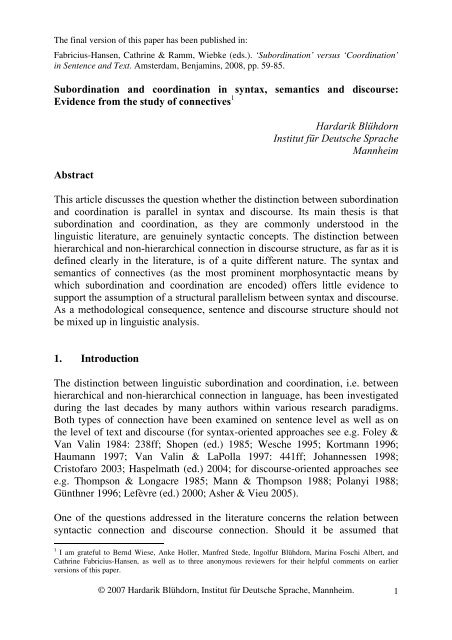
![Ãœbersetzungen-19[1]. - Institut für Deutsche Sprache](https://img.yumpu.com/51701205/1/184x260/aoebersetzungen-191-institut-fur-deutsche-sprache.jpg?quality=85)


